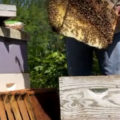The following is by Bruce Bordelon from the Purdue Wine Grape team. I’ve spoken to Bruce many times in the past about pruning, spray regimens and dealing with a number of issues in the vineyard. I respect his advice when it comes to growing grapes in Indiana. Looks like we will be in for a challenging Spring.
—-
The unusually mild winter has many people asking about what effects the mild temperatures are having on fruit crops. It’s a bit complicated. Most temperate zone plants like apples, grapes, blueberries, etc. go dormant in the fall and will remain dormant even though we may have some mild temperatures during the winter months. They are adapted to this climate by having a “chilling requirement” necessary for them to break dormancy. The must receive a certain amount of “chilling” in order to complete the dormancy process and begin normal grow in the spring. “Chilling” occurs when temperatures are in the range of 34 to 54˚F, with an optimum of about 42˚F. Temperatures colder than 34˚F do not satisfy the chilling requirement and temperatures above 54˚F can actually cause a loss of accumulated hours. There are several models to monitor chilling hour accumulation and the Utah model, developed in peaches, is widely used. The amount of chilling necessary varies by species and varieties, but for most fruit crops is in the range of 500-1,000 hours. Grapes are on the low end of that scale, and vary by variety and species background.
During normal winters, we accumulate some (200 or so) chilling hours in November, but few in December and January, as the average temperature gets too low to satisfy the chilling requirement. Chilling hours accumulate again in February and March, with most crops achieving the necessary hours to fulfill the requirement during the last month of winter. After that point, plants will be ready to respond to warm conditions and begin growth.
This year is unusual in that we received a significant number of chilling hours during December and January. In Tippecanoe County, for instance, we have accumulated 915 hours from Nov. 1 to Feb. 1. During the same period in 2011 we accumulated only 373 hours. At 915 hours we have satisfied the chilling requirement for grapes, raspberries, blackberries and peaches. Apples and blueberries need 1,000-1,200.
In addition to being no longer dormant, plants have also likely experienced cold hardiness de-acclimation in the past month. My colleagues in Ohio recently posted a nice article on this topic in the Ohio Grape-Wine Electronic Newsletter
So what does all this mean to Indiana fruit growers?
It means that your crops are no longer dormant, probably have reduced cold hardiness, and are ready to grow as soon as we get a few days of 50 degree weather. The risk of winter cold damage from temperatures near zero is diminished as we move through February, but the risk of spring freeze damage would be very high if plants begin growth before mid-March or early April. Recall that the frost free date (50% chance of 28˚F) is early May across central Indiana. We have a long way to go….
What can you do?
Growers can avoid frost damage by delaying pruning as long as possible. Unpruned plants are more cold hardy and their buds develop more slowly compared to pruned plants. Grape growers can also use a technique called “long or double pruning.” This method is especially good for varieties that tend to bud out early. The procedure utilizes the apical dominance of buds on a cane. The first buds to begin growing are those on the tip of a cane, while buds closer to the base begin growth later. To perform long pruning, select canes to be used for fruiting spurs during the normal pruning practice and remove the rest of the wood. Instead of cutting the selected canes back to 3-4 node spurs, leave them long, with 10-15 more buds than desired. The extra buds will help delay the development of the desired basal buds, which helps avoid frost injury. After the date of the last probable spring freeze has passed, the canes are shortened to the desired length to properly adjust the bud number for the vine. Growth of the basal buds can be delayed as much as two weeks if weather conditions are favorable. While this procedure requires an extra trip through the vineyard, it can mean the difference between a full crop and little or no crop.
I would be happy to answer questions and respond to comments.
~~~~~~~~~~~~~~~~~~~~~
Bruce Bordelon, Ph.D.
Professor and Extension Specialist, Viticulture and Small Fruit
Purdue University
Department of Horticulture and Landscape Architecture
625 Agriculture Mall Drive
West Lafayette, IN 47907-2010
http://www.hort.purdue.edu/fruitveg/











Leave a Reply